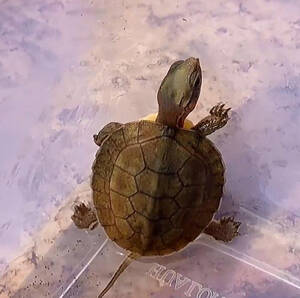Rafetus swinhoei
IUCN
LCBasic Information
Scientific classification
- name:Rafetus swinhoei
- Scientific Name:Rafetus swinhoei,Yangtze Giant Softshell Turtle;Swinhoe's softshell,Rùa Hồ Gươm,Taihu turtle, giant softshell turtle, spotted softshell turtle, and Stuart softshell turtle
- Outline:Testudines
- Family:Testudinidae G.turtle
Vital signs
- length:0.8-1.5 meters long
- Weight:100~200 kg
- lifetime:400 years old
Feature
The head, neck and back of the limbs are also dark green with irregular yellow spots of different sizes. This dense yellow pattern is a characteristic of the Yangtze giant softshell turtle.
Distribution and Habitat
Distributed in Jiangsu, Shanghai, Zhejiang, and Yunnan in China. Distributed abroad in Vietnam.
Lives in rivers, lakes, and swamps, and is bottom-dwelling. Usually lives in freshwater areas of the Yangtze River Basin and the Red River Basin. Inhabits slow or still waters associated with major rivers, dragged into the mud and debris at the bottom.
Appearance
It is large in size, with a large head, a short and broad fleshy nose, a short and thick snout, an oblong carapace, a smooth back, and a flat body with only a slight bulge. There are obvious irregular yellow spots of different sizes on the head and neck, and this dense yellow pattern is a characteristic of the Yangtze giant softshell turtle.
Details
In ancient times, the Yangtze giant softshell turtle was widely distributed in the lower reaches of the Yangtze River and the Taihu Lake area in China. The ancients called it the 癞头缋. Due to wanton hunting and ecological damage, no wild individuals have been found since 1972. There are only two confirmed surviving individuals. There is a male in Suzhou Zoo; there is a female in Changsha Zoo, which has been moved to Suzhou Zoo for artificial breeding (at 13:20 on April 13, 2019, this female Yangtze giant softshell turtle died during artificial insemination in Suzhou Zoo). In addition, there are two individuals, one male and one female, in the release pond of Suzhou Xiyuan Temple. The male (named Fang Fang) died in August 2007, and the female has not been actually observed; the two individuals in Shanghai Zoo and Beijing Zoo died in late 2006 and 2005, respectively. There is also news that American researchers have observed a wild Yangtze giant softshell turtle in northern Vietnam. There is still one turtle in Hanoi’s Hoan Kiem Lake. Legend has it that it once carried a sword and gave it to the founder of the Later Le Dynasty of Vietnam to help him conquer the world. However, some scholars believe that this turtle is a separate species and call it the Hoan Kiem Turtle (Vietnamese: Rùa Hồ Gươm).

Although it was named as early as 1873, the Yangtze giant softshell turtle has long been mistaken for the Chinese softshell turtle or the Chinese softshell turtle. It was not until 2002 that it was confirmed as a valid species.
The giant softshell turtle can stay underwater for a long time. It is carnivorous and has a ferocious temperament. Every year around the Waking of Insects, the giant softshell turtle hibernating in the mud at the bottom of the pond begins to wake up. The temperature in spring is still cold, and the giant softshell turtle in Suzhou Zoo only surfaces in the warm sunny afternoon, slowly swims with its head raised, and then crawls on the edge of the stone island in the pond. The whole turtle body is half submerged in shallow water, and remains motionless for a long time, just like a rock on the edge of the island. Usually, the turtle head submerged in water is raised every 2-3 minutes, and it sprays a small stream of water in its mouth while exhaling, then opens its mouth and lifts its nose to inhale, and sinks its head into the water again after 10-15 seconds, and this breathing action is repeated in an endless cycle.
The adult of this species is omnivorous. In China, captive Yangtze giant softshell turtles receive animal substances such as fish, various mammal meats, chicken, crayfish, snails, salad and other plants.
The Yangtze giant softshell turtle is extremely rare and precious, and is a "water panda" that is more endangered than the Chinese sturgeon. "Lv Shunqing, coordinator of the WCS Amphibian and Reptile Species Project, introduced that the Yangtze giant softshell turtle is the most endangered species among turtles, with only three known surviving in the world.
By the end of the 1990s, due to the massive increase in human activities and the huge demand for turtle shells in traditional Chinese medicine, the Yangtze giant softshell turtle population declined rapidly, with only four known individuals left, two living in Vietnam and two in Suzhou Zoo. At the end of 2011, one of the last four Yangtze giant softshell turtles in the world was discovered and protected in Hanoi, Vietnam.

On January 19, 2016, the "Centennial God Turtle" revered as a national treasure in Vietnam's Hoan Kiem Lake was confirmed dead. The turtle was temporarily moved to the Ngoc Son Temple for temporary placement, and will then be made into a specimen and collected in the Vietnam Natural History Museum.
One of the reasons for the decline in the number of giant softshell turtles is that people regard them as turtles and do not pay enough attention to them. Moreover, this species has high requirements for habitats and strong territorial behavior. If two turtles are placed in a pond, they will definitely fight until they kill each other. They need a very large range of habitats, including beaches, land and water.
The nutrients in the meat of turtles and tortoises can achieve the effects mentioned in ancient medical books through broad-spectrum vitamins or ordinary chicken. However, traditional Chinese eating habits have caused some modern people to ignore this fundamental fact and blindly pursue the so-called culture, which is a bad habit.








